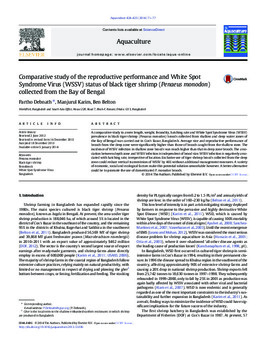Comparative study of the reproductive performance and White Spot Syndrome Virus (WSSV) status of black tiger shrimp (Penaeus monodon) collected from the Bay of Bengal

Citation
Debnath, P.; Karim, M.; Belton, B. (2014). Comparative study of the reproductive performance and White Spot Syndrome Virus (WSSV) status of black tiger shrimp (Penaeus monodon) collected from the Bay of Bengal. Aquaculture, 424-425: 71-77
A comparative study to assess length, weight, fecundity, hatching rate and White Spot Syndrome Virus (WSSV) prevalence in black tiger shrimp (Penaeus monodon) brood collected from shallow and deep water zones of the Bay of Bengal was carried out in Cox's Bazar, Bangladesh. Average size and reproductive performance of brood from the deep zone was significantly higher than in brood caught from the shallow zone. The incidence of WSSV infection in shallow zone brood was much higher than in deep zone brood. The association between depth zone and WSSV infection is independent of brood size. WSSV infection is negatively associated with hatching rate, irrespective of location. Exclusive use of tiger shrimp brood collected from the deep zone could reduce vertical transmission of WSSV by 46% without additional management measures. A variety of economic, social and ecological factors make this potential solution unworkable however. A better alternative could be to promote the use of domesticated P. monodon brood.
Permalink
Date Available
Type
Publisher
Countries
Research Themes